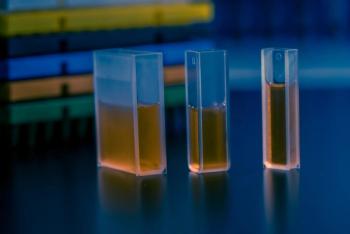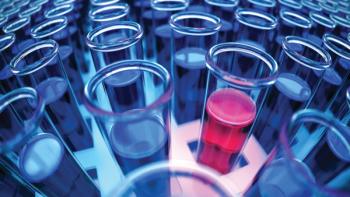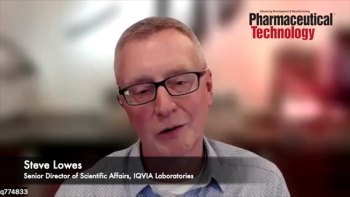
- Pharmaceutical Technology-04-02-2008
- Volume 32
- Issue 4
Spectrophotometric Determination of Lead
The authors developed a reliable spectrophotometric method for determining and measuring trace amounts of lead in various samples.
Lead has long been recognized as a hazardous metal to fish and other wildlife (1). For humans, lead is a neurotoxic metallic element that can be absorbed by the body primarily through the lungs and stomach. Lead poisoning occurs when repeated exposure to a lead-containing environment happens so that lead is slowly accumulated in bones and tissues.
(NICHOLAS EVELEIGH/GETTY IMAGES)
Exposure to high concentrations of lead can cause serious health problems, including nervous system dysfunction of fetuses and infants, hemotoxic effects, reproductive dysfunction, gastrointestinal tract alterations, nephropathies, and Alzheimer's disease. Lead poisoning is related to anemia, because the activity of heme synthetic enzymes can be inhibited by lead ions (2). Lead is also a risk factor for hypertension in women (3). If lead poisoning is left untreated, it may damage kidneys, the nervous system, and the brain. Because of the possibility of permanent impairment, lead poisoning is particularly dangerous during infant development and for children under 7 years of age, who can absorb 50% of lead ingested, compared with adults who only absorb 10% of it (4). In 1985, the
As a metal that has been widely used in industry for many years, lead is omnipresent in the environment—either from natural resources or from pollutants. In the United States, the average lead background level in soil is 7– 40 ppm (5–7). The maximum allowable lead level in food is 2 ppm (6). In agricultural products, food, raw dietary supplements, and pharmaceutical materials, lead usually exists at levels <1 ppm. To determine lead at ppm or sub-ppm levels, some analytical instruments with high-sensitivity detection capabilities are available, including inductively coupled plasma mass spectroscopy (ICP-MS) and graphite furnace atomic absorption spectroscopy (GFAAS) (8–13). Ion chromatography also has been used for lead determination; however, its sensitivity is not as good as that of ICP-MS and GFAAS (14–15).
Although their sensitivities make ICP-MS and GFAAS the methods of choice for lead analysis, they are very expensive. For example, a typical ICP-MS instrument ranges in price from $250,000 to $750,000, and daily operational cost can be more than $1000. In addition, because only a small amount of sample solution can be introduced into the instrument, both ICP-MS and GFAAS require a very clean working environment, which adds maintenance cost to operate the instruments, especially an ICP-MS. Therefore, many analytical laboratories cannot afford an ICP-MS. Moreover, for laboratories in which lead analysis is not a routine task, it is not economically worthwhile to own a GFAAS instrument, even though it is less expensive (more than $20,000). Those laboratories prefer sending their samples to other laboratories for lead determination, even though sending samples to an outside laboratory costs money and time.
To analyze low-level lead quickly, simply, and less expensively, a few analytical methods for lead determination have been developed in the past 10 years. Di Nezio et al. have reported a preconcentration technique involving flow injection spectrophotometry to detect lead in natural water samples (16). Other examples include a dibromo-p-methylsulfonazo spectrophotometric method to detect lead in biological samples, a resonance Rayleigh scattering method to detect lead in tap-water samples, and a fluorescent method to detect lead in soft drinks (17–19). However, these methods have their shortcomings: either they could only be used for water or liquid samples, or their detection limits were too high, or they were not tolerant of other common metal ions.
The method reported in this article is based on the complex formation of lead with dithizone or diphenylthiocarbazone. Although dithizone has been used for lead analysis for more than half a century, limited research has been conducted on the sample digestion and few studies have been conducted on reagent recycling (20–23).
Application of this complex reagent is very limited. A colorimetric method based on a lead-dithizone complex is the procedure recommended for lead analysis according to the US Pharmacopeia (24). Unfortunately, this method can be used only for simple samples and has serious shortcomings. For instance, the method is invalid for samples containing lead at levels <5 ppm. The shortcomings of the USP method include:
- It is not suitable for salts of alkali earth elements because a heavy precipitation is formed during the sample digestion process
- For many samples the digestion process is extremely time-consuming—it can take several hours or even days
- Detection limit is too high for almost all common samples
- The method generates too much waste of dithizone chloroform solution, which is both environmentally and economically unacceptable.
We discuss a practical UV–vis spectrophotometric method for measuring trace amounts of lead (e.g., <1 ppm). The method is applicable to all organic and inorganic samples and eliminates all the shortcomings mentioned for the USP method. It is simple, economical (<$2/sample), reliable, and versatile for any type of sample. The procedure has been validated by standard addition method and a ICP-MS method. Its sensitivity is at sub-ppm levels, similar as those of ICP-MS and GFAAS. Using this method, lead in pharmaceutical, agricultural, food, and raw dietary supplement samples have been determined.
Experiment
Materials and instruments. The following materials were used: lead stock standard solution, 1000 ppm (analytical grade); chloroform (HPLC grade); dithizone (diphenylthiocarbazone, p.a. grade); diethyldithiocarbamic acid sodium salt (p.a. grade); hydroxylamine hydrochloride (p.a. grade); ammonium hydroxide (ACS reagent grade); nitric acid (ACS reagent grade); hydrogen peroxide 35% (p.a. grade); and sulfuric acid (p.a. grade), which were all purchased from Acros (Morris Plains, NJ). Citric acid (reagent grade) and potassium cyanide (reagent grade) were from
Reagent preparations. First, we diluted the 1000 ppm of lead stock solution with 1% HNO3 to 1.0 ppm. Then a 0.003% dithizone extraction solution was made as follows: 30 mg dithizone were dissolved in 1000 mL of chloroform, and 5 mL of ethanol were added as a stabilizer. The solution was stored in a refrigerator. Each time before use, we washed a suitable volume of the dithizone solution with half of its volume of 1% HCl. After washing, the aqueous phase was discarded. We prepared a 0.001% standard dithizone solution by dissolving 10 mg of dithizone in 1000 mL of chloroform and storing it in a refrigerator.
To prepare the 30% ammonium citrate solution, we dissolved 60 g of citric acid in approximately 100 mL of DI water. Two drops of 0.1% phenol red in ethanol were added, and the pH was adjusted with ammonium hydroxide until the indicator turned from yellow to pink. Any lead present in the citric acid was removed by extracting the solution with 10 mL of 0.003% dithizone extraction solution. The extraction was repeated until the dithizone solution did not change color. The citrate solution was then diulted to 200 mL.
To prepare the 2% ammonium cyanide solution, we dissolved 2 g of potassium cyanide in 15 mL of ammonium hydroxide, then diluted it with DI water to 100 mL. For the 5% potassium cyanide solution, we dissolved 25 g of potassium cyanide in sufficient water to make 100 mL. We removed lead from this solution by repeated extracting with 10 mL of 0.003% dithizone extraction solution until the dithizone solution did not change color. We removed any remaining dithizone from the aqueous solution by extracting with 10 mL of chloroform and repeated this process three times. We then diluted the cyanide solution with DI water to 500 mL.
To prepare the 20% hydroxylamine hydrochloride solution, we dissolved 20 g of hydroxylamine hydrochloride in sufficient DI water to make ~60 mL. Five drops of 0.1% thymol blue in the ethanol solution were added, and the pH was adjusted with ammonium hydroxide until a yellow color appeared. We added and dissolved 0.4 g sodium diethyldithiocarbamate, and allowed it to stand for 5 min. The solution was extracted five times with successive 10 mL of chloroform. Drop by drop, we added 3 N hydrochloric acid until the solution became pink, and then diluted it to 100 mL with DI water.
All reagent solutions were kept in a refrigerator and were stable for at least four weeks.
Figure 1: The complex of lead and dithizone formed in weak basic solution. Lead to ligand ratio is 1:2.
Analytical procedure. In a weak alkaline solution, dithizone can form a stable complex with lead in a 2:1 ratio (see Figure 1). This complex has a maximum absorbance at 520 nm (see Figure 2). To obtain reliable results, the key step was to quantitatively dissolve and then isolate lead from the sample matrix. The optimized and validated analytical procedure follows.
Step 1. Into a 250-mL beaker, weigh an appropriate amount of samples containing ≤25 μg of lead, such as 1–2 g of inorganic sample, 5 g of a mixture sample of inorganic and organic, or 10 g of organic sample. Add 10 mL of 1:1 H2SO4 (1:1 of H2SO4–H2O, v/v) and a few glass beads into the beaker. Cover the beaker with a piece of watching glass and heat the beaker on a hot plate until the sample becomes brown or dark brown.
Figure 2: Spectrophotometric scans of a blank dithizone solution (blue), 1 μg/5 mL (red) and 4 μg/5 mL (purple) of lead-dithizone solutions.
Step 2. Drop by drop carefully add H2O2 (35%), until the organic materials are completely destroyed, which is indicated by the solution becoming clear. For mineral-containing samples, some white residue will remain.
Step 3. For some samples of mixed organic and inorganic materials, H2SO4–H2O2 may not be able to destroy the organic components completely. In this case, alternatively adding H2O2 and HNO3 could speed the digestion. Wait for evolution of SO3 smoke before switching solvents.
Step 4. For alkaline earth-salt samples such as dicalcium phosphate, H2SO4 should be avoided for digestion because it can form heavy precipitation with the metal ions and make the lead separation impossible. For these types of samples, neat nitric acid is sufficient.
Step 5. After sample digestion, let the solution cool to room temperature. Wash the beaker with approximately 10 mL of DI water. Heat the solution again until SO3 smoke is evolved. Repeat the washing and heating one more time to remove any residual H2O2. If H2O2 is not completely removed, it will fail the lead extraction separation.
Step 6. Add 10 mL of DI water to the sample beaker and stir to dissolve any water-soluble salt. Add 5 mL of 30% ammonium citrate solution, 2 mL of 20% hydroxylamine hydrochloride solution, and mix well. (Note: For alkaline earth-salt samples, do not add the 10 mL of DI water, instead add 20 mL of 30% ammonium citrate and 2 mL of 20% hydroxylamine hydrochloride solution, and mix well.)
Step 7. Add two drops of 0.1% phenol red in ethanol. Carefully adjust the pH with ammonium hydroxide until the solution changes colors from pink to yellow then back to pink again. Cool the solution to room temperature. Completely transfer the sample to a 125-mL separatory funnel for liquid–liquid extraction of the lead.
Step 8. Into the separatory funnel containing the sample solution, add 2 mL of 5% potassium cyanide solution and 5 mL of 0.003% dithizone extraction solution. Shake the separatory funnel for ~30 s, carefully releasing pressure from time to time. Drain the bottom dithizone phase to a 60-mL separatory funnel containing 20 mL of 1% HCl, which is used for back extraction of lead.
Repeat the extraction three more times. Collect all the dithizone phases in the 60-mL separatory funnel. The original aqueous sample solution should be collected in a specific container for waste treatment.
Step 9. Shake the 60-mL separator funnel for 45 s to back-extract lead to the acidic aqueous phase. Drain the dithizone phase into a beaker containing 20 mL of DI water to recycle the dithizone solution.
Step 10. In the 60-mL separatory funnel, add 4 mL of 2% ammonium cyanide and 5 mL of 0.001% standard dithizone solution. Shake the separatory funnel for 45 s. Drain the dithizone solution into a 10-mL of centrifuge tube for the spectrophotometric determination of lead.
Step 11. To construct the standard calibration curve, extract lead standard solutions containing 0.0, 1.0, 5.0, 10.0, and 25 μg of lead in the same way as described in steps 6–10. Using chloroform as a reference, measure the absorbances of the solutions at 520 nm. Create a calibration curve from the measured results. The R2 value should be .0.990.
Step 12. Measure the absorbance of the samples at 520 nm. Calculate the lead concentration based on the standard calibration curve obtained at Step 11.
For quality assurance, we performed triplicate analyses for all samples.
Results and discussion
Method validation. The method was validated using two means: standard addition or method recovery and comparison with an accepted ICP-MS method.
Method recovery results. Two samples with nondetectable lead were specifically chosen for lead recovery testing. These samples were spiked with 0.5 –3.0 μg of lead, and triplicate analyses were performed in the same manner as for the regular samples. Table I lists the lead recovery test results. In these tests, 10 g of dried hotdog bun powder and 2 g of green tea extract were used.
Table I: Lead recovery test results (n 5 3).
Comparison with ICP-MS results. Analytical results obtained with the UV–vis method have been validated by comparison with those acquired with a well-established ICP-MS method from a second laboratory. Table II provides method validation results for three different samples. Comparing the lead results obtained from the ICP-MS and from our UV–vis method, we can conclude that the UV–vis method is reliable and accurate.
Table II: Comparison of analytical results of lead from UVâvis and ICP-MS methods (μg/g).
Lead analysis results. Using the UV–vis method described above, lead in several samples and at various levels has been successfully determined. Each sample was analyzed in triplicate and the average was reported. Table III lists analysis results of lead in some agricultural, food, and raw dietary supplement materials.
Table III: Lead analytical results of some common samples (n = 3).
In all the samples listed in Table III, 2.0 μg of standard lead were always spiked for quality assurance. The accepted recovery result at our R&D department is set at 1.8–3.0 μg (90– 150% of the spiked lead). For all the samples, the percentage recoveries always fall in the range of 90–120%, and none are out of the accepted range.
Based on the lead analytical and recovery test results, the procedure described previously is effective for all materials included in the study. For most of the samples, the digestion time is <1 h. For some complicated dietary supplements, which might either contain certain compounds with high molecular weights or a mixture of organic and minerals ingredients, the digestion time may take as long as 2 h. In comparison, to digest this type of sample could take as long as 8 h, or even a couple days, if using the USP method (24).
The last two samples in Table III, hydrox 6% FD and olive extract, are samples that would be extremely difficult to digest if using the USP method. For such samples, repeated treatment with H2SO4–HNO3 or H2SO4–H2O2 would dramatically shorten the digestion time, usually by 2 h. For salt samples of alkaline earth metals, such as dicalcium phosphate, the USP digestion method does not work (24). Dicalcium phosphate contains ~29% calcium and 70% phosphate. If concentrated H2SO4 is used for the digestion, then a heavy precipitation is formed at pH adjustment (step 7). Mere HNO3 can also dissolve the sample, but if not enough masking reagent is used, then the calcium phosphate also will precipitate out when ammonium hydroxide is added to adjust the pH. In both cases, the precipitation makes it impossible to separate the lead from the sample solution. After trying different approaches and various masking reagents, we found the best way to avoid this problem was to:
- Use smaller amount of samples (e.g., 2 g instead of 5–10 g) (step 1)
- Add 30 mL of ammonium citrate as masking reagent instead of 5 mL (step 6)
- Stir the sample solution while slowly adding ammonium hydroxide to adjust the pH (step 7).
Following all other procedures as stated previously, trace amounts of lead in the salts of alkaline earth metals was successfully determined (see Table I).
In this reported method, dithizone extraction solution was washed with 1% HCl rather than 1% of HNO3 as in the USP method (24) because a trace amount of HNO3 left in the dithizone solution could rapidly decompose the dithizone. After replacing 1% of HNO3 with 1% of HCl, the decomposition problem did not happen again.
To maximally reduce the consumption of chloroform, some preliminary experiments were performed for the recycling of the dithizone chloroform solution. We found the following procedure could be used for recycling the dithizone chloroform solution: After lead extraction, the 0.003% dithizone solution is washed with 20 mL of DI water, followed by 20 mL of 1% of HC, and then washed again with 20 mL of DI water. After washing, a small amount of ethanol is added into the dithizone solution, 1 mL to 100 mL (1:100 v/v), to stabilize the dithizone. This solution should be kept in a refrigerator until next time of use. Based on our experimental results, the dithizone solution could be reused for as many as 10 times, as long as the greenish-blue color retains stable.
Conclusion
This method was used in our quality control laboratory for several months with various samples and proved to be reliable for the determination of trace amounts of lead in all samples. From sample digestion to interfering element masking and to dithizone chloroform solution recycling, each step has been optimized. For certain mixture samples of organic ingredients and minerals, repeated treatment with H2SO4–H2O2 and H2SO4–HNO3 is very effective and could reduce the digestion time dramatically. For the determination of ppm levels of lead in salts of alkaline earth metals, sulfuric acid should be avoided and an extra amount of citrate reagent should be used to prevent the precipitation. Recycling the dithizone solution can not only reduce the consumption of chloroform but also maximally lower the overall cost. This method is very rugged and could be used for routine analysis of trace amounts of lead as well as for the validation of other instrumental methods such as ICP-MS or GFAA.
Lang Lang is a senior student at School of Pharmacy & Allied Health Science, University of Montana, Missoula, MT. Konghwa Chiu is a professor in the department of applied science, National Hualien University of Education, Taiwan, ROC. Qingyong Lang* is a senior analytical chemist in the R&D department at Nutritional Laboratories International, Missoula, MT,
*To whom all correspondence should be addressed.
Submitted: Aug. 21, 2007. Accepted: Dec.3, 2007
Reference
1. R. Eisler, "Lead Hazards to Fish, Wildlife, and Invertebrates: A Synoptic Review," Biological Report 85(1.14), Contaminant Hazard Reviews, US Fish and Wildlife Service (1988), available at
2. C. Rubio et al., "Lead Dietary Intake in Spanish Population (Canary Islands)" J. Agric. Food Chem. 53 (16), 6543–6549 (2005).
3. D. K. Houston and M. A. Johnson, "Blood Lead Level is Associated with Elevated Blood Pressure in Blacks," Nutr. Rev. 57 (9 Part 1), 277–279 (1999).
4. California Poison Control System, "Lead Poisoning," available at
5. FDA, 21 CFR Part 173 "Secondary Direct Food Additives Permitted in Food for Human Consumption," (2002), available at
6. T. Logan, Lead Contamination in the Garden,
7. G. G. Holmgren et al., "Cadmium, Lead, Copper, and Nickel in Agriculatural Soils of the United States of America," J. Environ. Qual.22, 335–348 (1993).
8. West Coast Analytical Service, "Lead in Supplements and Antacids," (2002), available at
9. US Department of Agriculture, Determination of Cadmium and Lead by ICP-MS, available at
10. B. S. Sheppard, D. T. Heitkemper, and C. M. Gaston, "Microwave Digestion for the Determination of Arsenic, Cadmium, and Lead in Seafood Products by Inductively Coupled Plasma Atomic Emission and Mass Spectrometry," The Analyst, 119, 1683–1686 (1994).
11. K. Ndung'u, S. Hibdon, and A.R. Flegal, "Determination of Lead in Vinegar by ICP-MS and GFAAS: Evaluation of Different Sample Preparation Procedures," Talanta 64 (1), 258 – 263 (2004).
12. E. Hahn et al., "SS-GFAAS: An Ideal Method for the Evaluation of Lead and Cadmium Profiles in Birds' Feathers," Fresenius' J. Anal. Chem., 337 (3), 306–309 (1990).
13. X. Zhang et al., "GFAAS Determination of Trace Lead in Toothpase Using L'vov Platform,"Guang Pu Xue Yu Guang Pu Fen Xi, 19 (3), 388–391 (1999).
14. W. Bashir, S. G. Butler, and B. Paull, "Determination of Lead in Water Samples Using Ion Chromatography with a Xylenol Orange Containing Eluent," Analytical Letters 34 (9), 1529–1540 (2001).
15. N.G. Sellers, "Ion-Exchange Separation and Determination of Lead in Steel by Atomic Absorption," Anal. Chem., 44 (2), 410–411 (1972).
16. M.S. Di Nezio, M. E. Palomeque, and B.S. Fernandez Band, "A Sensitive Spectrophotometric Method for Lead Determination by Flow Injection Analysis with On-Line Preconcentration," Talanta 63 (2), 405–409 (2004).
17. Z.J. Li et al., "Spectrophotometric Determination of Lead in Biological Samples with Dibromo-p-methyl-methylsulfonazo," Talanta 48 (3), 511–516 (1999).
18. D. Wang, H.Q. Luo, and N.B. Li, "Resonance Rayleigh Scattering Method for the Determination of Trace Amounts of Lead(II) with 1-(2-Pyridylazo)-2-Napththol Dye," Instrumentation Sci. Technol. 33 (4), 427– 436 (2005).
19. Y. J. Dong and K. Gai, "Determination of Trace Amounts of Lead by Spectrofluorimetry," Hydrometallurgy of China, 24 (3), 172–174 (2005).
20. J.C. Gage, "The Determination of Tracs of Lead and Bismuth in Organic Material," The Analyst 83, 672–674 (1958).
21. A. Weber and V. B. Vouk, "The Extraction Constant of Lead Dithizonate," The Analyst 85, 40, 46 (1960).
22. O. B. Mathre and E. B. Sandell, "Lead-Dithizone Equilibria in Water-Carbon Tetrachloride Systems," Talanta11, 295–314 (1964).
23. R. A. Jones and A. Szutka, "Determination of Microgram Quantitites of Lead by Spectrophotometric Titration with Dithizone," Anal. Chem. 38, 779 –781 (1966).
24. USP–NF, vol. 1 (US Pharmacopeial Convention, Rockville, MD, 2007), pp. 147–148.
What would you do differently? Email your thoughts about this paper to
Articles in this issue
over 17 years ago
Suppositories: The Incomplete Storyover 17 years ago
A Transformation in the Makingover 17 years ago
Vapors, Venison, and Videosover 17 years ago
Inside IPEC-EUROPE: Pharmaceutical Excipients—The View from the EUover 17 years ago
Measuring Excipient-Market Growthover 17 years ago
Report From: China, May 2008over 17 years ago
Weak Link in the Pharmaceutical Supply Chainover 17 years ago
Message in a Bottleover 17 years ago
Tracking the Potential of Excipientsover 17 years ago
Coming Down the Pike: Bispecific mABsNewsletter
Get the essential updates shaping the future of pharma manufacturing and compliance—subscribe today to Pharmaceutical Technology and never miss a breakthrough.



